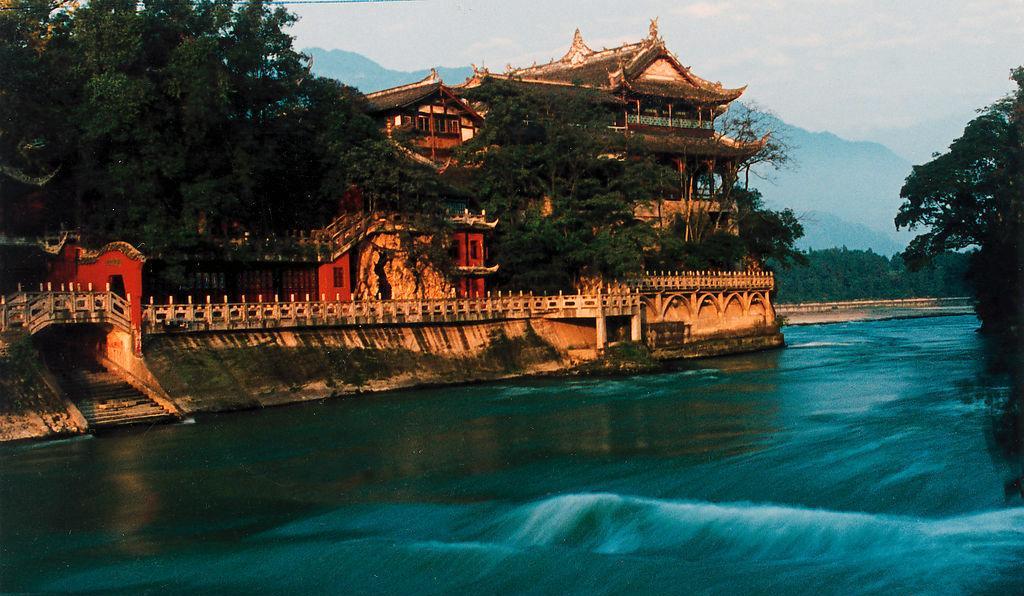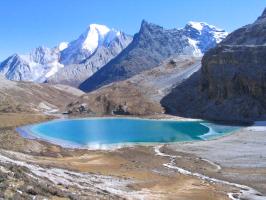Dujiangyan Irrigation System
Dujiang Weir, also named Dujiangyan Irrigation Project or Dujiangyan Irrigation System, is located in the west of Dujiangyan City, Sichuan Province. Originally it was called Du'an Weir after the name of the ancient Du'an County, where the weir was situated.
Since Song and Yuan Dynasty it was given the present name Dujiang Weir, honored as the "Guarding Treasure of Sichuan Province" that is "ingenious of all times". The weir represents ancient Chinese superb science and technology and is a milestone in the world's water harnessing and irrigation history. Known as the world's oldest diversion project without a dam, it still feeds a grid of irrigation canals watering 670,000 hectares (1,675,000 acres) of farmland, turning the province into the country's famous land of abundance since ancient times.
In the third century, a Chinese poet wrote down the following lines praising the richness of what is Sichuan Province today.
Both rain and drought follow the will of the people
Famine is unknown,
Time has not seen a lean year,
Everyone knows it is a "land of abundance."
The phrase "land of abundance" is very well known now and reminds most Chinese people of Sichuan. But not everyone knows exactly why the province got its name. In fact, it got the name thanks to the construction of the Dujianyan Irrigation Project more than 2,200 years ago.
Fifty-five kilometers from Chengdu, the provincial capital, Dujiangyan is the world's oldest hydropower project still in use. In ancient times, the Chengdu Plain, now one of China's most populous and important agricultural regions, suffered from the incessant flooding of the Minjiang River, a tributary of the Yangtze River, in Summer, while it was stricken with drought in winter.
The then Sichuan Governor Li Bing decided to harness the Minjiang River and started the construction of Dujiangyan Irrigation Project around 256 BC. He divided the river by a long bank in the middle, with the inner river serving as the irrigation, and the outer river used as a floodway. Downstream, on one side of the inner river, there is a narrow opening between the two hills. The opening, named the Precious Bottleneck Channel, leads water into the irrigation network.
Linking the channel are two curing channels of the outer river, both higher than the Precious Bottleneck Channel itself. This guarantees the inner river has enough water in the dry season. When floods come, any unwanted water flows back into the mainstream of the Minjiang River. The
Precious Bottleneck Channel's inflow is balanced with a weir formerly made of bamboo cages filled with stones. This is the key to the Dujiangyan Irrigation Project. The project employs techniques displaying the simple virtues of practicality and reliability. Modern hydrographers say the Precious Bottleneck Channel's intake has been stable since 1937.
When the project was built, it fed a grid of irrigation canals watering 160,000 hectares (400,000 acres). Thanks to the project, the plain has stayed more or less free of drought for more than 2,000 years, and hence the name the "land of abundance." Located in Dujiangyan, a city under the jurisdiction of Chengdu, the project, which works without a dam, is hailed as one of the world's most impressive hydraulic engineering projects and is a must for tourists heading for Chengdu.
Dujiang Weir, Sichuan ToursTo prepare for the application, the city invested more than US $ 24 million to improve the environment at Mount Qingcheng and the Dujiangyan Irrigation Project. It demolished 280,000 square meters of buildings and relocated 61 factories, schools, hotels, and 1,097 households that were not in keeping with the natural scenery.
Experts from the UNESCO have acclaimed the city's efforts. In February 2000, Dr Les Molloy, an expert from UNESCO, said Mount Qingcheng is one of the most wonderful places in Asia, and Dujiangyan is utterly beautiful. In recent years, Dujiangyan invested more than US $ 36 million on urban construction to give its streets major facelifts and install street lamps. Urban infrastructure construction has been accelerated to ensure that the city is a sea of trees and flowers during the daytime and a sea of lights at night.
Dujiang Weir, Sichuan ToursThe land around the City of Chengdu is rich and beautiful, with clear blue rivers and undulating green hills. It is difficult to believe that a good part of this area owes its fertility to a man who lived more than two thousand years ago. Magistrate Li Bing of the Qin Dynasty, assisted by his son designed and supervised the building of a huge water control project northwest of the city which channeled Minjiang River waters to irrigate
croplands. The father and son were posthumously granted the title of prince by later emperors, and the Two-Prince Temple (aka Two-Emperor Temple or Erwang Temple) still stands today on a hill overlooking the ingeniously devised water diversion structures.
The Four Ancient Water Conservancy Projects
The four ancient water conservancy projects in China are Dujiangyan Irrigation Project in Chengdu, Sichuan Province, the Ling Canal in Guilin, Guangxi Zhuang Autonomous Region, the Grand Canal from Beijing to Hangzhou and the karez, an irrigation system of wells connected by underground channels used in Xinjiang Uygur Autonomous Region.















